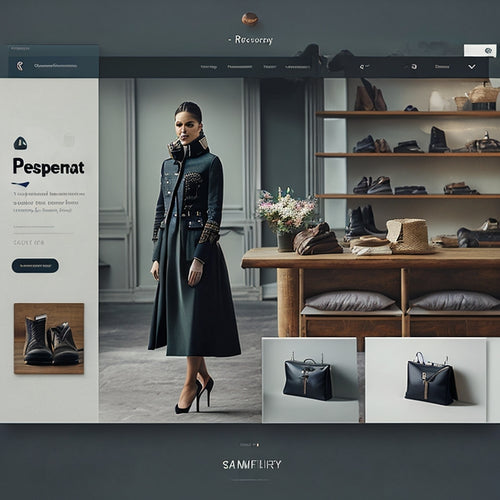
Revolutionize E-Commerce With Vue.Js Tricks
Share
You can revolutionize your e-commerce development by harnessing Vue.js's capabilities to harness fast, scalable, and customizable online stores. Start by setting up a Vue project and installing Commerce.js to tap into online shopping trends. Then, create reusable product components to efficiently render product data and lay the groundwork for a scalable e-commerce application. Next, fetch product data from Chec using Commerce.js and store it in the products data object. Finally, render the ProductsList component in the App component to seamlessly display products to customers. Now, you're on the path to harnessing the full potential of Vue.js for e-commerce success.
Key Takeaways
• Set up a solid Vue project foundation to tap into online shopping trends and focus on a unique shopping experience.
• Leverage Commerce.js features to access e-commerce functionality, streamline development, and enhance customer experience.
• Create reusable ProductItem and ProductsList components to efficiently render product data and improve user interface design.
• Break down product data into manageable parts using Vue.js components to enhance scalability and efficiency.
• Seamlessly display products to customers by fetching data from Chec and rendering the ProductsList component with Commerce.js.
Building E-Commerce Foundation
To lay the groundwork for your e-commerce application, you'll need to set up a Vue project and install Commerce.js, an essential step in building a robust e-commerce foundation.
This integration will enable you to tap into the latest online shopping trends, providing a seamless experience for your customers. With Vue.js integration, you'll have a solid foundation for your application, allowing you to focus on crafting a unique shopping experience.
By leveraging Commerce.js, you'll be able to access a wide range of e-commerce features, streamlining your development process.
Crafting Product Components
By creating reusable product components, you'll be able to efficiently render product data and lay the groundwork for a scalable e-commerce application. You can break down your product data into smaller, manageable pieces using Vue.js components.
Start by creating a ProductItem component, which will serve as a single product card. This component should accept a product prop, allowing you to pass in the necessary data.
Then, create a ProductsList component that imports and registers the ProductItem component. This will enable you to loop through an array of products and render each one as a ProductItem component.
Displaying Products With Commerce.Js
You'll now use Commerce.js to fetch product data, then render it in your ProductsList component, seamlessly displaying your products to customers. This is where the magic happens, and your e-commerce store starts taking shape.
| Step | Description |
|---|---|
| 1 | Fetch product data from Chec using Commerce.js |
| 2 | Store product data in the products data object |
| 3 | Render ProductsList component in App component |
Frequently Asked Questions
Can I Use Commerce.Js With Other Javascript Frameworks Besides Vue.Js?
You can use Commerce.js with other JavaScript frameworks besides Vue.js, thanks to its cross-platform integration and framework flexibility, allowing you to seamlessly integrate it with your preferred framework for a tailored e-commerce solution.
How Do I Handle Errors and Exceptions in Commerce.Js API Calls?
You might think error handling is a hassle, but Commerce.js makes it a breeze. You'll wrap API calls with try-catch blocks and leverage API wrappers for error handling, ensuring your e-commerce app stays robust and reliable.
Are There Any Security Concerns When Using Commerce.Js With Vue.Js?
You should prioritize data encryption and use secure protocols when integrating Commerce.js with Vue.js to guarantee sensitive data protection. Use HTTPS and SSL certificates to encrypt data in transit, and follow Commerce.js security guidelines to prevent unauthorized access.
Can I Customize the Commerce.Js API to Fit My Specific E-Commerce Needs?
As you tailor your e-commerce solution, think of Commerce.js as a canvas, waiting for your brushstrokes of customization. You can indeed customize the API to fit your needs with API Extensions and strategic Code Tweaks, enabling a bespoke commerce experience.
Is Commerce.Js Compatible With Server-Side Rendering in Vue.Js Applications?
You'll be pleased to know that Commerce.js is compatible with server-side rendering (SSR) in Vue.js applications, allowing for SSR optimization and seamless Vue integration, making it a great choice for your e-commerce needs.
Related Posts
-
How Can Behind-the-scenes Footage Create a Stronger Connection Between Brands and Consumers?
Behind-the-scenes footage has become a powerful tool in brand marketing, allowing brands to connect with consumers o...
-

Effortlessly Enhance Your Shopify Store With Pagefly and Fera Integration
The integration of PageFly and Fera offers a seamless solution for enhancing the design and functionality of Shopify...
-

Products Shopify Apps Support Merchants in Managing and Analyzing Their Product Offerings, With Features Like Bulk Product Editors and Inventory Analysis Systems
This article explores the role of products Shopify apps in assisting merchants with the management and analysis of t...

